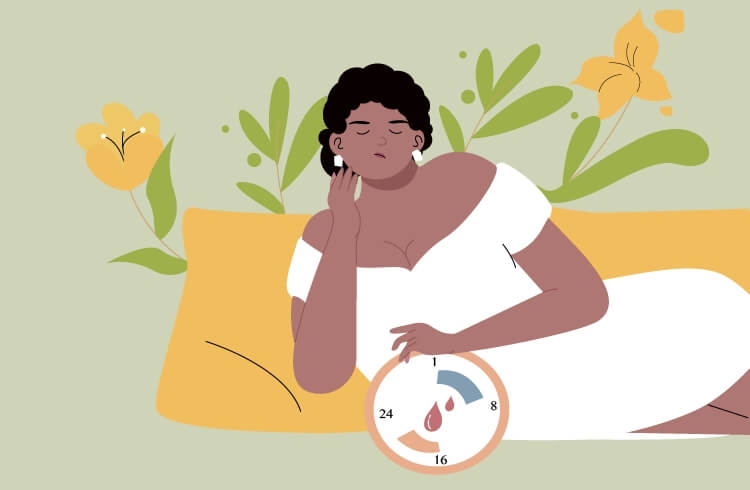What will I learn today?
- Why and how logging data helps you interpret your cycle
- The most helpful things to log
- Key things to look out for in each cycle
Why does this matter when trying to get pregnant?
Learning from each cycle will help you to predict your fertile window in the next - allowing you to time sex for pregnancy!
The Importance of Menstrual Cycle Tracking for Faster Pregnancy
Menstrual cycle tracking is an essential tool for women who are trying to conceive. By monitoring their menstrual cycle, women can determine when they are most likely to conceive, known as the fertile window.
Identifying the Fertile Window: This is the period when they are most likely to conceive. This is usually around 5-6 days before ovulation and 1-2 days after ovulation. Knowing the fertile window helps women find the right time for intercourse to increase their chances of conceiving.
Predicting Ovulation: Ovulation is when the matured follicle releases an egg. By tracking basal body temperature, and cervical mucus, or using ovulation prediction kits, women can identify their ovulation date, making it easier to time intercourse for conception.
Identifying Potential Issues: Menstrual cycle tracking can also help identify potential issues with the menstrual cycle that may be affecting fertility. For example, irregular cycles, anovulation, or luteal phase defects can be detected through tracking, which can then be addressed with medical intervention.
What to Log When Tracking Your Menstrual Cycle
Tracking menstrual cycles for pregnancy requires careful interpretation and monitoring to understand and manage it effectively. The more you log, the more data you have to compare each cycle. Among all the menstrual-related symptoms, including both internal and external ones, your cycle length, bleeding patterns BBT, CM, and LH are the most important things to log. Let's dive in one by one.
Cycle length
Your cycle starts on the first day of your period, when you bleed from your uterus (womb), and ends on the day before your next period. The average menstrual cycle lasts 28 days, but it's normal to have cycles that are shorter or longer, ranging from 21 to 35 days. Your cycle length may also change from month to month or at different stages of your life. And it also varies between people.
Bleeding pattern
Menstrual bleeding patterns vary in the number of days, amount, flow, and color of the fluid. It also varies between each menstrual cycle and at different life stages.
Basal body temperature
Your basal body temperature (BBT) is your temperature when you're fully at rest. People usually take their BBT after at least 6 hours of uninterrupted sleeping, and before any physical moves are made. Ovulation may cause a slight increase in basal body temperature. You'll be most fertile during the two to three days before your temperature rises, which is why it can be used as a way to predict fertility or as a part of a method of contraception, by helping you gauge the best days to have or avoid unprotected sex.
Cervical mucus
Cervical mucus, commonly known as the discharge is produced by the same hormones that control your menstrual cycle. It is an important physiological feature of the female reproductive system. Cervical mucus changes color, texture, odor, and amount during your menstrual cycle. And the changes can be very obvious around ovulation. It has a typical pattern during the menstrual cycle. Therefore, tracking whether your cervical mucus is stretchy or creamy, helps to identify your fertile window.
Luteinizing Hormone
LH plays an important role in aiding in egg maturation and providing the hormonal trigger to cause ovulation and the release of mature eggs from the ovary-this is ovulation. Ovulation normally occurs 24-36 hours after the LH surge appears which is why the LH surge is a good predictor of peak fertility.
Other Symptoms to Notice
Other helpful things to log are physical symptoms, moods, and sexual activity. These will often be connected to both ovulation and the onset of your period.
Your body goes through many changes after ovulation. Your breasts may become swollen and tender, your bowel habits may change, you may feel more sexual, and find your partner irresistible, and you might even have a stronger sense of taste and smell - all of these changes are governed by the hormone fluctuations that take place in each cycle, and are nature's ways of helping you to time intercourse for pregnancy. So it’s best if you can get into the habit of tracking as you go along each day.
Understanding Menstrual Symptoms and What They Indicate for Fertility
Your menstrual cycle is not only a way to track your period, but also a window into your fertility. By paying attention to your menstrual symptoms, you can learn more about your ovulation, hormone levels, and reproductive health. Some menstrual symptoms that can indicate your fertility status include
Period length and heaviness: signs of fertility problems or hormonal issues.
The length and heaviness of your period can vary from cycle to cycle and person to person. However, if you notice significant changes in these aspects of your period, it could be a sign of a fertility problem. For example, very heavy periods could indicate fibroids (noncancerous growths in the uterus) or endometriosis (a condition where tissue similar to the lining of the uterus grows outside it). Very light periods could indicate low estrogen levels or polycystic ovary syndrome (PCOS), a hormonal disorder that affects ovulation.
Cervical mucus changes: indicators of ovulation and fertile days.
Cervical mucus changes throughout your cycle depending on your hormonal levels. You can tell the types of cervical mucus you currently have by one of three ways: using your fingers, with toilet paper, and by checking your underwear (please choose one method only throughout each cycle).
Dry: Cervical mucus is usually dry before or after the period. Your cervical mucus is dry and small in amount. During this time, it is hard for sperm to enter the cervix and stay alive. You are in your infertile phase.
Sticky: Thick cervical mucus is smooth. It's like liquid glue, but less thick. It will break when stretched.
Creamy: Looks like a white emulsion. It is stretchier than thick cervical mucus. It will appear during your fertile phase and indicates that you are ovulating soon.
Watery: Watery and thin. Stretchier than creamy cervical mucus and looks clearer. Watery cervical mucus will make your underwear damp. You won't miss it. Watery cervical mucus doesn't indicate the highest probability of conception, but it is possible.
Egg white: It is very clear and stretchier and thicker than watery cervical mucus. Just like real egg white, you can stretch it by about 3cm on the tip of your finger. Egg-white cervical mucus indicates that you have the highest probability of conception. During this time it creates the right PH conditions for the sperm and creates channels for them to swim along.
(Download Femometer App to record your cervical mucus changes)
LH surge: trigger of ovulation and how to detect it.
About a day or two before an egg is released from the ovary, LH levels rise sharply. This increase in LH helps to prepare the egg and the fallopian tube for fertilization. After ovulation, LH also helps to activate the corpus luteum, which is a structure that forms from the empty egg follicle. The corpus luteum produces progesterone, a hormone that supports early pregnancy if the egg is fertilized. LH levels drop back to normal after the LH surge.
LH levels will be at their highest after LH surge around ovulation. If you have your LH levels tested around this time, you can expect a PEAK result.
It's also very helpful to watch how your LH levels interact with your BBT chart. Some women find that they see their LH surge and their BBT rises straight away, whilst others will find their BBT rises slowly over 3 or 4 days.
(Shop Femometer Ivy103 Ovulation Predictor Kit to test LH levels)
BBT rise: confirmation of ovulation.
Record your daily basal body temperature and look for a pattern to emerge. You can do this with Femometer App that is designed for this purpose. Basal body temperature may increase slightly — typically less than a 1/2 degree F (0.3 C) — when you ovulate. Ovulation has likely occurred when the slightly higher temperature remains steady for three days or more.
Take your basal body temperature every morning before getting out of bed. Use a specifically designed basal thermometer to measure basal body temperature. Make sure you get at least 6 hours of uninterrupted sleep each night to ensure an accurate reading.
(Shop Femometer App Surpported Basal Thermometer Vinca 2.0))
How to Effectively Track Your Menstrual Cycle for Improved Fertility
There are two primary methods to help you track menstrual cycles: manual tracking and using intelligent fertility tracker apps.
Intelligent fertility tracker apps are the ideal choice compared with manual tracking when accuracy, effectiveness, and time consumption are considered.
We've designed Femometer so that you can understand what your unique cycle and symptoms are. We give you insights, predictions, and advice along the way, and help you to predict your fertile window and ovulation, but ideally, our app will help you to identify what you need to look out for each cycle. Femtometer's fertility tracker can help you with the listed points:
- Calendar functions for tracking fertility, ovulation, menstruation, BBT, LH, cervical mucus, and sexual activity.
- Personalized predictions based on daily inputs and algorithms that adjust to your cycle patterns.
- Insightful reporting that provides insights into fertility trends, health tips, and reminders.
- Smart devices integration that can measure BBT & LH.
- Community support that connects users with other women who are trying to conceive and experts who can offer advice.
Round up!
- Logging BBT, CM, and LH are key for interpreting cycles
- Watch for clear, stretchy CM as this means you’re fertile
- Watch for a rise in your BBT to confirm ovulation
- Watch for a surge in LH to help you identify when ovulation will take place
This article is the original creation of Femometer. All rights reserved by Femometer Inc. To reproduce, distribute, or reference the content, please reach out to us in advance to prevent any potential legal issues. Copyright © Femometer Inc.









